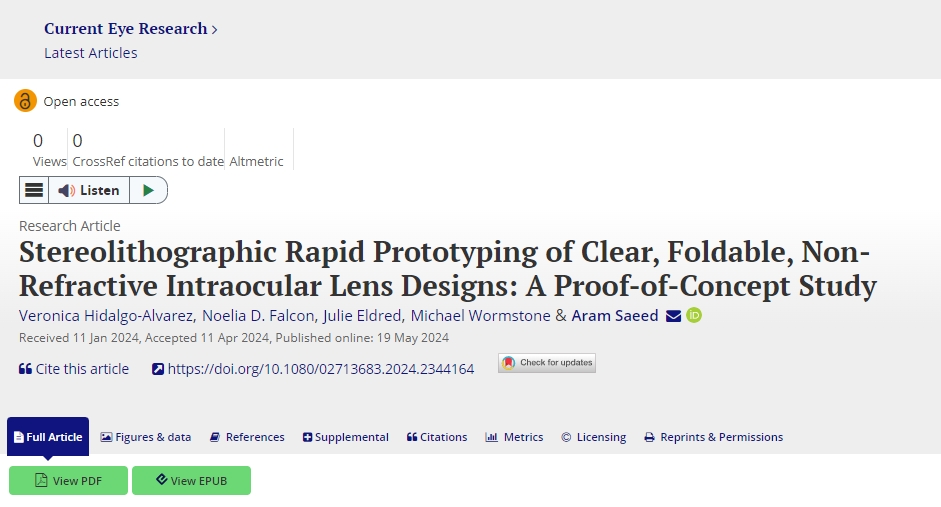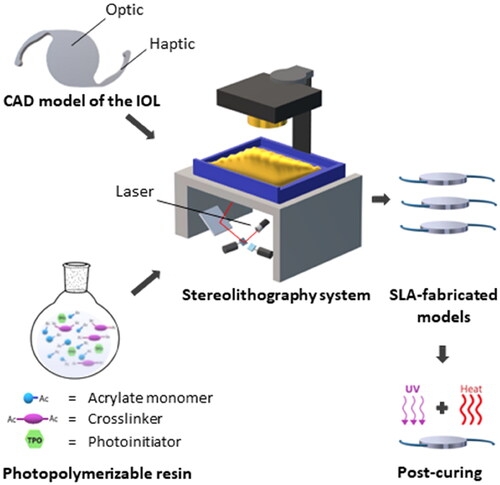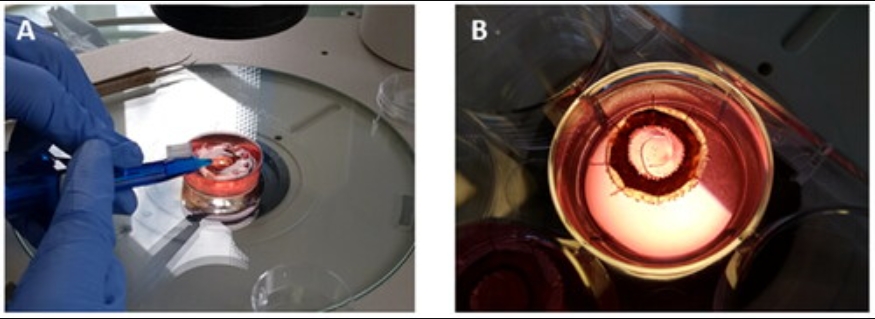Cataract is a cloudy area in the lens. It is the main cause of blindness and the second leading cause of severe visual impairment worldwide. In cataract surgery, it is necessary to remove the cloudy lens and replace it with an artificial lens to restore refractive power. However, the current molding and lathe technologies used to manufacture artificial lenses are complex and time-consuming, which limits the development of new materials and designs.

The study has been published in the journal Current Eye Research, titled "Stereolithography Rapid Prototyping of Transparent, Foldable, and Non Refractive Artificial Lens Design: A Conceptual Validation Study"
On May 20, 2024, the Antarctic Bear learned that researchers at the University of East Anglia have made progress in ophthalmic equipment technology by developing a new method for manufacturing artificial lenses using
a process based on stereolithography to address the limitations of traditional manufacturing processes. This innovation has the potential to improve the manufacturing of eye implants commonly used in cataract and
refractive surgery.
These artificial lenses can also be used to correct refractive errors, such as myopia, hyperopia, and presbyopia (where the eye gradually loses the ability to see things up close, which is a normal part of aging).
Dr. Aram Saeed, Associate Professor of Medical Technology at the School of Pharmacy at the University of East Anglia and the main author of the study, said, "We have developed for the first time a resin that can be used
for direct printing of ophthalmic devices. Although it is still in its early stages, the ability to 3D print these lenses can significantly enhance patient eye care by providing unprecedented levels of customization and design
accuracy, potentially leading to better clinical outcomes."

A schematic diagram of the production of lensed 3D objects without refractive function through stereolithography technology. A resin composed of acrylic monomers and crosslinking agents was developed and used for
this purpose
Technical research and development background
In history, artificial lenses have been made of various materials, including glass and silicone. Although the industry has shown significant development recently, mainly using acrylic materials. Currently, hydrophilic and
hydrophobic acrylic resins are the most commonly used materials due to their excellent optical transparency, flexibility, biocompatibility with the body, as well as stability and safety in the eyes.
The current methods for manufacturing artificial lenses typically use lathe machining and molding techniques. Although these methods can produce devices with well-designed and high optical quality, they also have
inherent limitations, especially in terms of design complexity and customization.
Aram Saeed said, "3D printing can significantly improve the production of ophthalmic equipment, not only increasing manufacturing speed and accuracy, but also increasing design complexity and customization. Our
concept validation paper is the first in a series of papers, which will provide a detailed introduction to our progress in this field and lay the foundation for changing global eye care practices. Our work combines materials
science with healthcare technology, requiring extensive professional knowledge to develop these types of ophthalmic devices. As we continue to publish our research results and share our progress, our goal is to stay at
the forefront of the industry, collaborate with industrial partners and researchers around the world, and improve and enhance technology."

Implant the lens model made of SLA into the human capsule in vitro
Although still in the early stages of development, this innovation may have the following advantages:
Customized lenses: 3D printing can customize lenses according to the shape and vision needs of each patient's eyes, which may improve vision correction and comfort.
Faster production: Compared to traditional methods, 3D printing has the potential to achieve faster lens design, testing, and manufacturing. This speed can shorten the time between diagnosis and surgery, providing
patients with faster care.
● Complex design: 3D printing can create complex lens shapes that were previously difficult to manufacture. These designs can better address a wider range of vision issues.
● Cost reduction: The production cost of customized or high-quality lenses through the use of 3D printing may be reduced, making it affordable for more patients, especially in economically impoverished areas. This may
lead to better overall public health outcomes.
● Compatibility with imaging: researchers hope that in the future, the combination of 3D printing and advanced imaging technology can help to produce lenses that are most suitable for the eyes of individual patients,
thus reducing the need for postoperative adjustment or complications.
Material innovation: 3D printing can develop new materials with improved optical properties. This may lead to lenses not only correcting vision, but also enhancing vision.

Research has found that 3D printed lenses have good optical clarity and can be folded and implanted into human bags
Co author and Honorary Professor at UEA School of Biological Sciences, Michael Wormstone, said, "If further developed successfully, this new technology can change the entire industry by implementing portable
manufacturing solutions, especially for remote and economically disadvantaged areas. In addition, it has the potential to support the production of high-quality customized lenses, thereby improving surgical outcomes in
more advanced healthcare environments."
Mr. Anas Injarie, Chief Ophthalmologist at NNUH with over 20 years of experience, said, "This innovation has the potential to produce lenses that meet patient specifications in terms of design and optical performance. For
the high-end market, it represents the exciting possibility of providing customized treatments that can improve patient satisfaction and surgical success rates."
The research results of the team have been patented.






